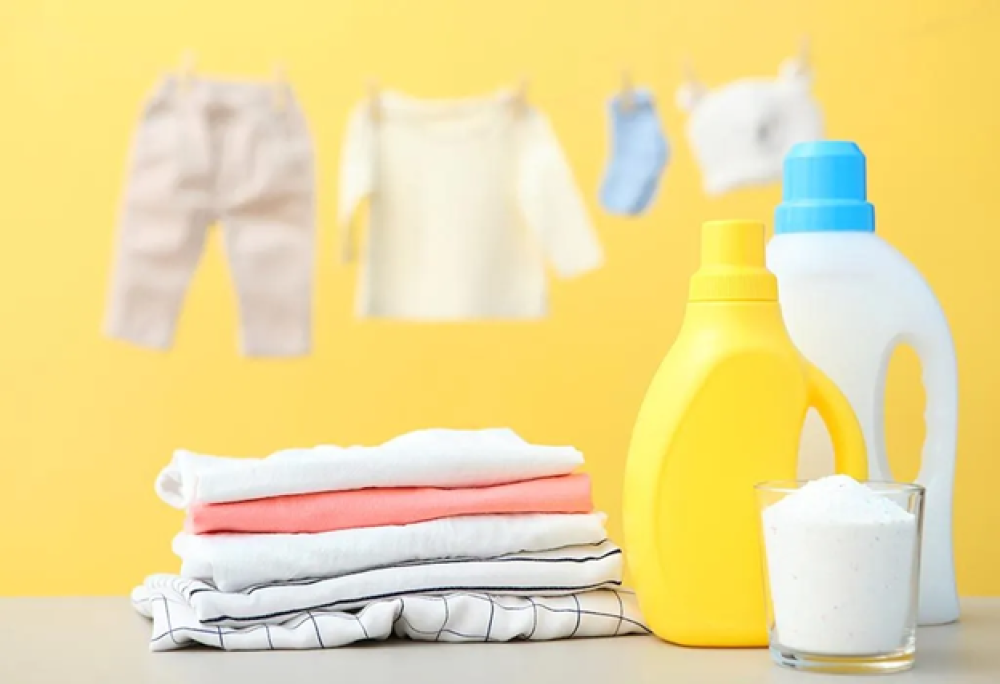Washing baby clothes isn't just a daily routine for mothers; it's an essential step in maintaining their child's health and comfort. Given their sensitive skin, their clothes require special care using specialized detergents and effective cleaning methods that gently remove stains without causing irritation. As we mentioned in the previous article about cleaning steps and choosing a good baby laundry soap to protect your child's skin, caring for baby clothes isn't limited to washing alone. It extends to other equally important steps, such as sterilization to ensure they're free of bacteria and germs, followed by proper storage to keep them clean, soft, and ready to use at any time.
In this article, we'll take you on a detailed journey to complement what we mentioned earlier and learn effective sterilization techniques, as well as proper storage methods that keep clothes soft and smelling fresh for as long as possible.
Link to the previous article: Washing Baby Clothes: Your Comprehensive Guide
Methods for sterilizing children's clothes:
Washing baby clothes is an essential step to keeping them clean and protecting your baby's delicate skin from pollutants. However, regular washing may not be enough to eliminate the germs and bacteria that accumulate on clothes, especially after playing outdoors or being exposed to crowded places. Therefore, sterilizing clothes after washing them is essential to ensure maximum hygiene and safety.
Especially since regular washing may remove stains, it's not always enough to eliminate all germs, especially if washed in cold water or with detergents not specifically designed for sterilization. Therefore, here are a few tips to enhance the effectiveness of washing in eliminating germs, such as:
Water temperature: It is preferable to wash clothes at a high temperature (60°C or higher) when they need to be sterilized, but attention must be paid to the nature of the fabric to avoid damaging it.
Type of detergent used: Choose a baby laundry soap that is free of harsh chemicals and has antibacterial properties.
Add an extra rinse cycle: Helps remove detergent residue and germs left on clothes.
Therefore, regular washing alone does not guarantee complete elimination of germs, which requires the use of additional sterilization methods to enhance cleaning effectiveness, including:
Use natural laundry detergents
Instead of resorting to harsh chemicals, you can use natural alternatives to sterilize baby clothes in a safe and effective way, such as:
White vinegar: Adding half a cup of white vinegar to the final rinse cycle helps eliminate germs and softens fabrics without the need for chemical softeners.
Lemon juice: It has disinfectant properties. Clothes can be soaked in warm water with lemon juice added before washing to help kill bacteria and eliminate unpleasant odors.
Sunlight: Sunlight is one of the best natural ways to sterilize clothes after washing, as ultraviolet rays help kill germs naturally.
With our knowledge of good sterilization methods, and as we mentioned in the previous article about effective drying methods, we will discuss here the correct ways to store children's clothes after washing them.
The best way to store baby clothes
Washing baby clothes is an essential step to keeping them clean and protecting your baby's delicate skin from germs and dirt. However, after washing and sterilizing, proper storage is just as important. Storing clothes improperly can damage the fabric or expose them to dust and moisture, affecting your baby's health and comfort. In this article, we'll learn about the best ways to store baby clothes after washing, how to protect them from external factors, and tips for keeping them organized and avoiding mixing them with other clothes.
The best way to fold clothes
After washing and thoroughly drying your baby's clothes, the next step is to properly fold them to save space and keep them in good condition. Here are some tips for folding baby clothes efficiently:
Use the vertical folding method: This method helps organize clothes inside drawers in an organized and easy-to-access manner without having to take out all the pieces.
Sort clothes by type: Group similar clothes together, such as shirts, pants, underwear, and socks, to make them easier to find when needed.
Roll small clothes: Instead of folding them, clothes such as pants and socks can be rolled to save space in drawers or boxes.
Avoid excessive folding: Some clothes, such as cotton dresses and shirts, may need to be hung rather than folded to maintain their shape and avoid wrinkles.
Storing children's clothes in a way that protects them from dust and moisture:
Storing children's clothing properly protects it from external factors that may affect its quality or cause allergies. Here are some ways to keep clothes clean and safe after storage:
Use sealed storage boxes or bags: Plastic boxes or zippered bags help prevent dust from accumulating on clothes, especially those not used daily.
Make sure to air out your stored clothes from time to time: It's best to open your closet or drawers from time to time to allow fresh air to enter, which prevents the buildup of odors and moisture.
Choose a suitable storage location: Avoid storing baby clothes in areas prone to moisture, such as basements or near bathrooms. Instead, choose dry, well-ventilated areas to keep the clothes in good condition.
Tips to avoid mixing baby clothes with other clothes
It's important to allocate a separate space for children's clothes in the closet or drawers to avoid mixing them with adult clothing or outerwear, which may harbor germs and dirt. Here are some tips to ensure optimal clothing organization:
Designate a separate drawer or shelf for baby clothes: This helps keep all items organized and easy to access without having to search through them.
Use drawer organizers: Dividers can be used inside drawers to divide clothes into categories, such as everyday clothes, pajamas, and socks.
Wash baby clothes separately: It is best to wash baby clothes using baby laundry soap designed for sensitive skin, and avoid putting them in the washing machine with other clothes.
Label baby clothes: If you use an outside laundry or have more than one child, small tags can be placed on the clothes to avoid confusion between different baby clothes.
Washing baby clothes isn't just a household chore; it's an essential part of daily care that ensures your child's comfort and safety. By using the right baby laundry soap, following proper sterilization steps, and storing baby clothes correctly, you can keep clothes clean and protect your little one's skin from any substances that might irritate them. Don't forget that consistent clothing care, from washing to storing, ensures peace of mind and ensures every item is ready to give your child the warmth and softness they deserve.

